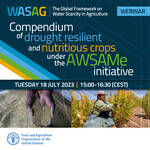Farmers' Guidelines on Soil and Water Management in Salt-affected Areas
The threats posed by salt-affected soils to global food security are increasing with climate change. According to the recent global salt-affected soils map, over 424 million hectares of topsoil (0–30 cm) and 833 million hectares of subsoil (30-100 cm) are currently salt-affected. The Saline Agriculture Working Group of the Global Framework on Water Scarcity in Agriculture (WASAG) developed practical guidelines for farmers implementing agriculture in salt-affected areas to assist them in their decision-making processes in dealing with salinity and sodicity issues in their lands [...]
Compendium of drought resilient and nutritious crops under AWSAMe initiative
Water crisis is among the top five crises that will have the largest impact in the next decade. Exacerbated by climate change, growing scarcity and competition for water stand as major threats to future advances in food security, nutrition and poverty alleviation, with further impacts on the environment and human health, especially in rural areas. There are currently 2.3 billion people who live in water-stressed countries, of which more than 733 million people – approximately 10% of the global population – live in countries with high and critical water stress. Accounting for approximately 70% of global freshwater withdrawals, agriculture is expected to suffer the greatest impact of water scarcity[...]
Community and indigenous strategies for climate change adaptation
Climate change has become an urgent challenge for life and the Earth. Populations at disproportionately higher risk of adverse consequences with global warming of 1.5℃ and beyond include disadvantaged and vulnerable populations, some indigenous peoples, and local communities dependent on agricultural or coastal livelihoods (IPCC, 2018)[...]
Achieving food security remains a major challenge in the East Africa region. With increasing demand for food due to population growth and improvements in disposable income, the situation is expected to remain critical as the impact of climate change and unsustainable land and water management practices become more profound. The discourse on sustainable intensification practices to meet growing food demand has [...]
Collaboration on Promoting Quinoa (Part 2)
Quinoa, which has high nutrient content and adaptability to various marginal conditions has been identified by various organizations, such as FAO, the Chinese Academy of Agricultural Sciences (CAAS), the International Center for Biosaline Agriculture (ICBA) and CIRAD, as a food that has a […]
Water Productivity Improvements – A Silver Bullet for the Climate Crisis?
This webinar was organized by leading institutions on sustainable agricultural water use, including the International Water Management Institute (IWMI), the CGIAR Research Program on Water, Land and Ecosystems (WLE), the World Bank, the African Union, Federal Office for Agriculture (FOAG), […]
Pandemics/Epidemics, Drought and Agriculture: Building back better
The Global Framework on Water Scarcity in Agriculture (WASAG) hosted by the FAO Land and Water Division recently held its seventh webinar under the title: Pandemics/Epidemics, Drought and Agriculture: Building back better […]
Water & Nutrition: From Research to Action
Water use in agriculture is fundamental for both food security and rural livelihoods, but also supports improved nutrition through many pathways; in tandem with water uses in other sectors, notably WASH. This webinar—which draws on the work of the WASAG Working Group on Water and Nutrition--describes the important linkages […]
Collaboration on Promoting Quinoa (Part 1)
Quinoa, which has high nutrient content and adaptability to various marginal conditions has been identified by various organizations, such as FAO, the International Center for Biosaline Agriculture (ICBA) and CIRAD, as a food that has vital role to play in the realization of food and nutrition […]
Bridging financing gaps for NDCs in agriculture under climate change
The Global Framework on Water Scarcity in Agriculture (WASAG) hosted by the FAO Land and Water Division organized its fourth webinar on "Bridging financing gaps for Nationally Determined Contributions in agriculture under climate change", which was held on Tuesday 9 June 2020 from […]
Soil and Water Management in salt-affected areas
The working group on “Saline Agriculture”, under the framework of WASAG, organized a webinar titled "Soil and water management in salt affected areas: practical solutions and tools" to share knowledge and experience in addressing the multiple challenges related to agriculture of these […]
Saline Agriculture – Scaling up Opportunities and Challenges
The Global Framework on Water Scarcity in Agriculture (WASAG) hosted by the FAO Land and Water Division held its second webinar on Saline Agriculture titled "Saline Agriculture: Scaling up Opportunities and Challenges". The objective of the webinar was to share knowledge and […]
Water scarcity, abundance of women?
The Global Framework on Water Scarcity in Agriculture (WASAG) hosted by the FAO Land and Water Division has organized a series of webinars in collaboration with its Partners. Together with the Women for Water Partnership (WfWP), a WASAG Partner, this first webinar on mainstreaming Gender in Water Scarcity in Agriculture under the title: WATER [...]
We at WASAG are aware that Zoom is not supported by all countries. Please check here for more information on this.
If Zoom is not supported in your country, please contact us at [email protected] for updates on when each webinar recording is posted.














